Gulf of Mexico Project Resources:

Beach-building (accretion) and erosion are natural processes. The desire to live and build structures on our coastlines exposes our homes, roads, commercial and industrial facilities, shipping ports, marinas, and other buildings to shoreline erosion.
Why do we care about the erosion along our coasts?
Our coastlines are currently home to 40% of the U.S. population. There is a long trend of higher growth on the coasts. The coastal area of the U.S. is twice as developed as the rest of the country: 8.8 %, versus 4.09% of the interior.
As global sea level rises, wave action and storm surge increase the likelihood of extensive coastal erosion. It is estimated that coastal erosion costs roughly $500 million per year for U.S. coastal property loss, including damage to structures and loss of land. As our climate continues to change, the increasing frequency of extreme weather threatens our shoreline communities.
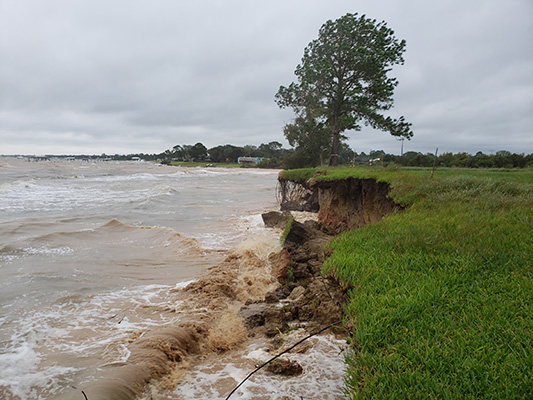
Our coastlines are currently home to 40% of the U.S. population. There is a long trend of higher growth on the coasts.
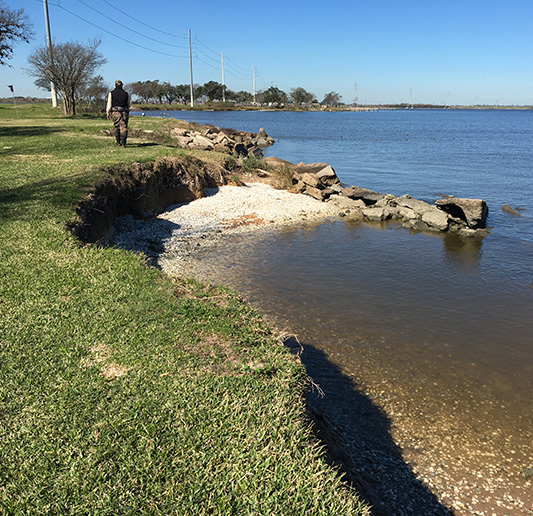
The United States’ “third” coast, the Gulf of Mexico, is an ocean basin formed approximately 300 million years ago by tectonic shifts. Because it is one of the world’s leading petroleum-producing regions, offshore industries have recently ushered in drastic changes to the Gulf’s shorelines.
In the past, the Gulf Coast was protected by buffering habitats, such as oyster reefs, seagrass beds, coastal forests, and marshes, that served to anchor shorelines and absorb surges. Over the past 100 years, a combination of naturally occurring and human-created changes has eroded these natural bulwarks. Rising sea levels have altered the salinity of the Mississippi Delta region, impacting ecosystems. Offshore, transit routes constructed by the petroleum industry have destroyed reefs and other native structures. With much of the natural buffering habitat damaged or destroyed, 64% of the Texas coast is eroding at an average rate of about 6 feet per year, with some locations losing more than 30 feet per year.
As the wetlands of the Gulf Coast grow increasingly submerged, shorefront homes and infrastructure are left vulnerable to destruction. The economic problems caused by Gulf Coast erosion are enmeshed with threats to its ecosystem. Because the region thrives on fisheries, farming, and tourism; rising water levels and vanishing beaches are devastating to local industry. Additionally, the escalated risk of flooding and structural damage has lowered coastal property values and left the entire region more vulnerable to hurricanes and tropical storms.
Restoring shoreline habitats is critical to solving the Gulf of Mexico’s persistent erosion. An estimated 16% of the Gulf of Mexico coastline is armored, yet living shorelines tend to cost less to install and maintain than artificially hardened ones. The reefs and marshes destroyed by construction and rising global temperatures can be rebuilt, returning the coastline to its natural state. These living shorelines are the key to mitigating the Gulf’s economic and ecological challenges.


Where it is feasible, returning our coastal estuaries and shoreline to a natural, undeveloped state can increase the resilience to storms, flooding, erosion, and other threats to these communities. Coastal wetlands are well known to be “natural sponges” that absorb floodwaters, putting the brakes on destructive wave action, and mitigating coastal erosion. Natural shorelines buffer storm surges, sequester carbon and other pollutants, and support a healthy habitat for commercially and recreationally important fish species.
Living shorelines, soft shore protection, installing oyster reefs, and other hybrid approaches are nature-based solutions to coastal erosion that can mimic nature while protecting your property and increasing critical habitat for marine species. Coastal restoration projects may replace a seawall or bulkhead with a natural beach, soft shore protection, salt marsh bordered by an oyster reef, or similar structure. One study found that living shorelines removed more than 50% of nitrogen from the water, and more was removed as sites matured.
Living shorelines are natural solutions to coastal erosion.
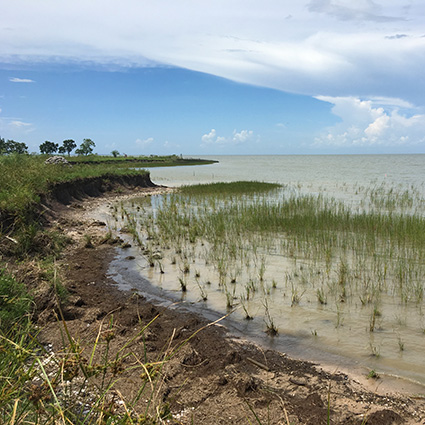
Protecting coastal communities has become increasingly important as the population grows and sea levels rise. However, artificial shoreline hardening has harmful impacts on wildlife and fish habitat. One study found that seawalls supported 23% lower biodiversity and 45% fewer organisms than natural shorelines.
Natural shore protection, or living shorelines, reduce erosion and flooding, while also creating or maintaining habitat. Living shoreline projects may replace a seawall or bulkhead with a natural beach, soft shore protection, salt marsh bordered by an oyster reef, or similar structures.
One study suggested that marshes protect shorelines from erosion better than bulkheads. It found that Hurricane Irene damaged 76% of bulkheads surveyed, while very little or no damage was found in marshes protected by living shorelines.
If you live on the shoreline, you will find a natural shoreline to be more beautiful and resilient than a bulkhead. Living shorelines are often more effective if they stretch along an entire beach rather than just one property. Consider connecting with your neighbors to build living shorelines.
If you do not live on the shoreline, consider volunteering to help with projects to restore coastal areas, such as planting marsh grasses and removing invasive plants.
A marsh sill is a type of low-profile stone structure used to contain sand fill to create a newly planted marsh that dissipates wave energy so that the marsh can establish and help reduce erosion farther inland.
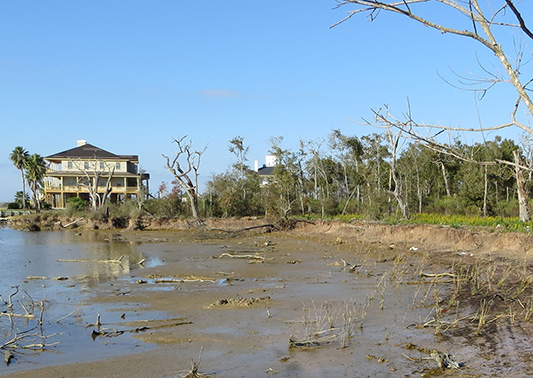
Before
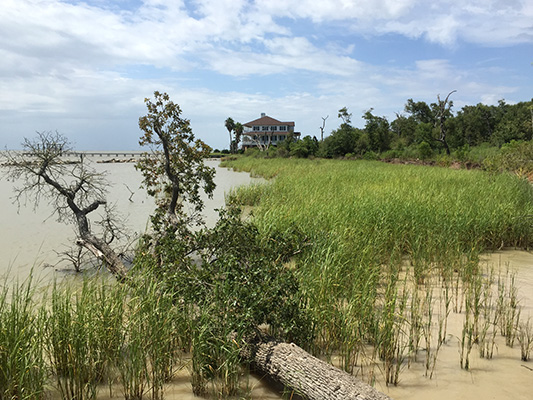
After
We need your help to improve the Toolkit by completing our easy, 3-minute survey. Your insight is valuable to us.